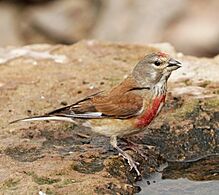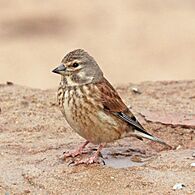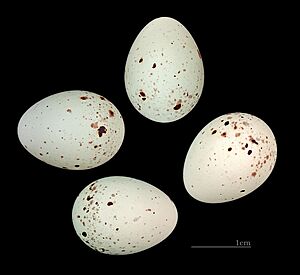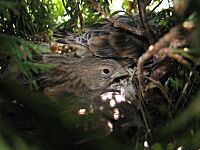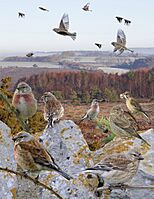Common linnet facts for kids
Quick facts for kids Common linnet |
|
|---|---|
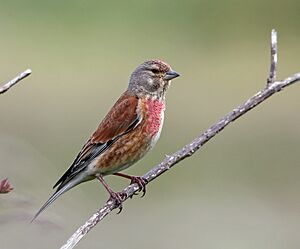 |
|
| Male in breeding plumage | |
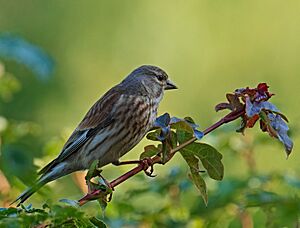 |
|
| Female | |
| Conservation status | |
| Scientific classification | |
| Genus: |
Linaria (bird)
|
| Species: |
cannabina
|
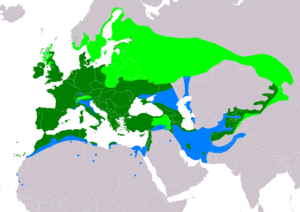 |
|
| Range of L. cannabina Breeding Resident Non-breeding | |
| Synonyms | |
|
|
The common linnet (Linaria cannabina) is a small passerine bird of the finch family, Fringillidae. It derives its common name and the scientific name, Linaria, from its fondness for hemp seeds and flax seeds—flax being the English name of the plant from which linen is made.
Taxonomy
In 1758, the Swedish naturalist Carl Linnaeus included the common linnet in the 10th edition of his Systema Naturae under the binomial name, Acanthis cannabina. The species was formerly placed in the genus Carduelis but based on the results of a phylogenetic analysis of mitochondrial and nuclear DNA sequences published in 2012, it was moved to the genus Linaria that had been introduced by the German naturalist Johann Matthäus Bechstein in 1802.
The genus name linaria is the Latin for a linen-weaver, from linum, "flax". The species name cannabina comes from the Latin for hemp. The English name has a similar root, being derived from Old French linette, from lin, "flax".
There are seven recognised subspecies:
- L. c. autochthona (Clancey, 1946) – Scotland
- L. c. cannabina (Linnaeus, 1758) – western, central and northern Europe, western and central Siberia. Non-breeding in north Africa and southwest Asia
- L. c. bella (Brehm, CL, 1845) – Middle East to Mongolia and northwestern China
- L. c. mediterranea (Tschusi, 1903) – Iberian Peninsula, Italy, Greece, northwest Africa and Mediterranean islands
- L. c. guentheri (Wolters, 1953) – Madeira
- L. c. meadewaldoi (Hartert, 1901) – western and central Canary Island (El Hierro and Gran Canaria)
- L. c. harterti (Bannerman, 1913) – eastern Canary Islands (Alegranza, Lanzarote and Fuerteventura)
Description
The common linnet is a slim bird with a long tail. The upper parts are brown, the throat is sullied white and the bill is grey. The summer male has a grey nape, red head-patch and red breast. Females and young birds lack the red and have white underparts, the breast streaked buff.
Distribution
The common linnet breeds in Europe, the western Palearctic and North Africa. It is partially resident, but many eastern and northern birds migrate farther south in the breeding range or move to the coasts. They are sometimes found several hundred miles off-shore. It has been introduced to the Dominican Republic.
Behaviour
Open land with thick bushes is favoured for breeding, including heathland and garden. It builds its nest in a bush, laying four to seven eggs.
This species can form large flocks outside the breeding season, sometimes mixed with other finches, such as twite, on coasts and salt marshes.
The common linnet's pleasant song contains fast trills and twitters.
It feeds on the ground, and low down in bushes, its food mainly consisting of seeds, which it also feeds to its chicks. It likes small to medium-sized seeds from most arable weeds, knotgrass, dock), crucifers (including charlock, shepherd's purse), chickweeds, dandelions, thistle, sow-thistle, mayweed, common groundsel, common hawthorn and birch. They have a small component of Invertebrates in their diet.
Conservation
The common linnet is listed by the UK Biodiversity Action Plan as a priority species. It is protected in the UK by the Wildlife and Countryside Act 1981.
In Britain, populations are declining, attributed to increasing use of herbicides, aggressive scrub removal and excessive hedge trimming; its population fell by 56% between 1968 and 1991, probably due to a decrease in seed supply and the increasing use of herbicide. From 1980 to 2009, according to the Pan-European Common Bird Monitoring Scheme, the European population decreased by 62%
Favourable management practices on agricultural land include:
- Set-aside
- Overwinter stubbles
- Uncultivated margins, ditches, field corners
- Conservation headlands
- Wild bird cover, using plants that produce small, oil-rich seeds, such as kale, quinoa, mustard plant and oil-seed rape Brassica napus
- Restoration of meadows: restoration and creation of hay-meadows
- Short, thick, thorny hedgerows and scrub for nesting habitat
Gallery



